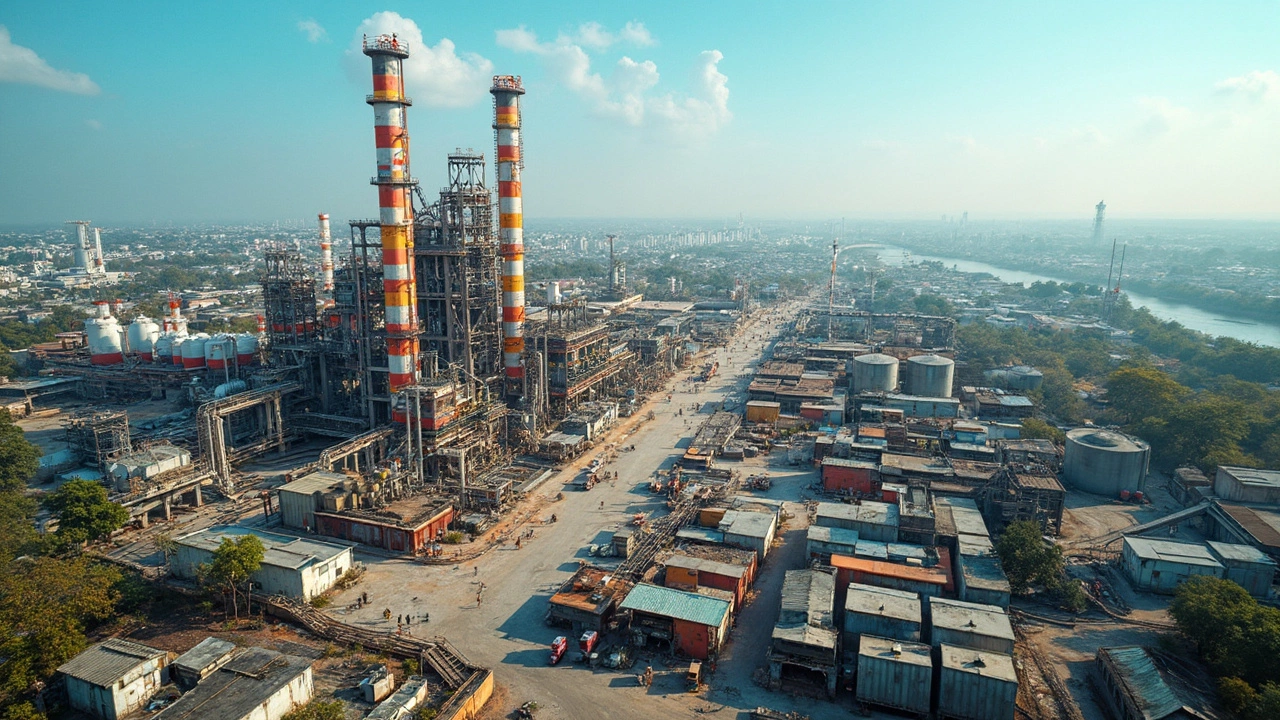Ever wondered where most of India’s chemicals come from? Let’s clear it up—Gujarat easily takes the crown as the country’s biggest chemical producer, and it’s not even close. If you’re in chemical manufacturing or thinking about entering the field, knowing what sets Gujarat apart is a game-changer.
The Indian chemical industry is huge—seriously, it’s the third largest in Asia. But here’s the thing: around 62% of the country’s chemical production happens in just one state. If you guess Gujarat, you’re spot on. From textiles and dyes to pharma chemicals, Gujarat churns out almost everything.
It’s not just about numbers. Companies in Gujarat benefit from easier logistics, constant supply of raw materials, and a government that loves setting up industrial parks (think Ankleshwar, Dahej, Vapi). That’s why big players like Reliance, Tata Chemicals, and UPL have such a strong base there.
If you want to make informed business moves or even just understand where that bottle of disinfectant or dye on your shelf comes from, you need to know why Gujarat leads and what you can learn from their approach. Trust me, it explains a whole lot about the industry dynamics in India.
- India’s Chemical Industry at a Glance
- Gujarat: The Undisputed Leader
- Why Gujarat Stays on Top
- Tips and Opportunities in the Chemical Sector
India’s Chemical Industry at a Glance
If you stack up all the big industries in India, chemicals are near the top—right behind IT and maybe a notch below steel. India is the sixth largest chemical producer in the world (by output value), and the sector is expected to be worth well over $300 billion by 2025. Not bad for something that powers everything from toothpaste and laundry detergents to farm fertilizers and paracetamol tablets.
What’s wild is how wide the chemical sector stretches here. It covers basic chemicals, specialty chemicals, agrochemicals, pharmaceuticals, dyes, and paints—so whatever business you’re into, chemicals probably play a part.
Here’s a quick look at just how big the industry is:
| Parameter | Data/Value |
|---|---|
| Total Industry Value (2025 estimate) | $300+ billion USD |
| Global Ranking (by output) | 6th |
| Employment Generated | 2+ million people |
| Share of India’s Manufacturing GDP | 16-17% |
| Share of World Chemicals Production | about 4% |
Exports? India ships chemicals to over 175 countries, including the US, China, Brazil, and major EU nations. The sector made up nearly 13% of total exports in 2023. If you’re wondering about jobs, the industry directly or indirectly pays the bills for more than 2 million families.
Growth is fueled by things like huge demand from agriculture, pharmaceuticals, and infrastructure. On top of that, new global supply trends (like companies moving away from China) are giving local chemical manufacturers extra momentum right now. If you pay attention to big business news, you’ll keep seeing this industry grab headlines.
Long story short, whether you’re a startup or a giant like Reliance, the chemical manufacturers India landscape is massive and still growing like crazy.
Gujarat: The Undisputed Leader
Gujarat is a true juggernaut when we talk about the chemical manufacturers India scene. This state alone makes up almost two-thirds of the country’s total chemical output. That’s not an exaggeration—about 62% of India’s chemical production comes straight from here.
The reason? Gujarat’s location along the western coast gives it a huge edge, especially for importing raw materials and exporting finished goods. But it’s not just geography. The state has around 3,500 chemical factories, way more than any other Indian state. Massive chemical zones like Dahej, Ankleshwar, and Vapi make it easy for manufacturers to find land, utilities, and a ready workforce.
Here’s a breakdown of Gujarat’s chemical dominance by the numbers:
| Statistic | Value |
|---|---|
| Share of India’s chemical output | ~62% |
| No. of chemical factories (2024) | 3,500+ |
| Major chemical hubs | Dahej, Ankleshwar, Vapi |
| No. of people employed | Approx. 1.5 million |
| Road/rail/port connections | Best in India for chemicals |
The state is especially big in petrochemicals, dyes, agrochemicals, and pharmaceuticals. You’ll notice global giants like Reliance Industries and Alembic set up shop here, but there’s also a strong network of smaller, family-owned companies fueling exports. If you check export numbers, Gujarat regularly accounts for over 70% of India’s chemical exports.
Another bonus: the Gujarat government has been serious about easing business. They set up single-window clearances, simplified environmental regulations, and organized cluster development. This isn’t just politics—it keeps investment flowing and makes it easier even for smaller businesses to scale up quickly.
For anyone looking at the chemical sector—whether to invest, find partners, or start something new—Gujarat pretty much sets the playbook. The numbers don’t lie, and neither does the steady stream of success stories coming out of the state.

Why Gujarat Stays on Top
If you want to know why Gujarat wins the race for chemical manufacturing, let’s get into the nuts and bolts. First, Gujarat’s geography is a massive advantage. It’s got a long coastline (about 1,600 km!) with direct access to ports like Kandla, Mundra, and Dahej. Shipping in raw materials or moving finished goods out is fast and cheap—something that companies love.
Next, Gujarat’s government has pushed hard to build smart infrastructure, not just roads and ports but special chemical hubs and industrial estates. The Gujarat Industrial Development Corporation (GIDC) has pumped out over 180 industrial estates, many designed specifically for chemical businesses. If you’re a new manufacturer, you get ready-to-use plots, good water supply, and easy power connections. Less hassle, more production—simple as that.
The state is also known for fewer red tapes and friendly business policies. Getting licenses and clearances is way quicker here. Huge multinational names and homegrown giants, like Reliance Industries and chemical manufacturers India leaders such as Tata Chemicals, have set up massive plants—for a reason.
Take a look at how Gujarat stacks up when it comes to chemical output, compared to two other big industrial states:
| State | Share of India's Chemical Production | Key Cities |
|---|---|---|
| Gujarat | 62% | Ankleshwar, Dahej, Vadodara, Vapi |
| Maharashtra | 16% | Mumbai, Thane, Navi Mumbai |
| Tamil Nadu | 5% | Chennai, Cuddalore |
Gujarat’s focus on skill development is another boost. Universities and training centers work directly with factories, churning out people who know what they’re doing. That means chemical units don’t waste time training from scratch.
One more not-so-obvious edge is Gujarat’s steady supply of raw materials like salt, limestone, and petroleum by-products. A lot of these resources are found locally, so manufacturers keep costs low and production smooth.
If you’re thinking about entering the chemical business or partnering with a top player, Gujarat’s business-friendly approach, supply chain perks, and talent pool make it the first place to look.
Tips and Opportunities in the Chemical Sector
If you’re looking to get into the chemical sector, you’re probably eyeing Gujarat—and for good reason. About 62% of India’s chemical output comes from this state. That means most of the chemical manufacturers India have set up shop here, and new players are always looking for a foot in the door.
So, what works in Gujarat that you can learn from?
- Industrial Parks: Plots in zones like Dahej or Vapi save companies a ton on logistics, water, and electricity. They come with readymade access to ports—huge for exports.
- Policy Perks: Gujarat’s government has rolled out regular tax breaks, simplified land purchases, and single-window clearances just for chemical units.
- Raw Material Availability: Locally sourced salt, petroleum products, and minerals cut down costs and speed up production.
- Cluster Approach: Hundreds of small and large chemical plants operate close together, making it easy to share infrastructure and services.
Before jumping in, you should know where the big demand is. Specialty chemicals, agrochemicals, and pharma chemicals are hot segments because of both local and export demand.
| Segment | Estimated Market Size (USD Billion, 2024) | Expected Growth Rate (Next 5 Years) |
|---|---|---|
| Specialty Chemicals | 40 | 11% |
| Agrochemicals | 8 | 8.5% |
| Pharma/Bulk Chemicals | 25 | 10% |
A quick tip—environmental compliance is a must. Indian regulators are strict, and Gujarat invests in common effluent treatment plants to help factories meet standards. Cutting corners on this can shut down operations fast.
Also, if you’re not a giant company, teaming up with others in the same industrial park helps you share costs and get bigger orders. Some small chemical players in Gujarat joined hands and landed export contracts they’d never have scored alone.
The biggest opportunity? Many global companies are reducing their dependency on China. India, especially Gujarat, is in a sweet spot to grab that business. If you can offer consistent quality and timely delivery, international clients are ready to talk.
Bottom line: The state welcomes serious chemical businesses with the infrastructure, incentives, and market access you need. Just remember to stay on top of local regulations, environmental rules, and new market trends so you’re not left behind.
